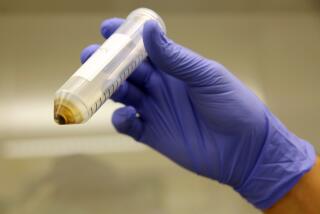Questions about some cosmetics
- Share via
Chemicals called phthalates are in everything from toys and vinyl flooring to food packaging and pharmaceutical products. They make plastics more flexible, nail polish more spreadable and creams and lotions smoother.
They’ve been used for years and have attracted little attention until recently. But a growing number of health and environmental activists are pushing to have cosmetics containing the chemicals banned or, at the very least, carry a label to warn consumers of their presence. The safety of phthalates in toys and plastic flood packaging is also coming under scrutiny.
Studies in animals have shown that phthalates (pronounced THA lates) increase the risk of reproductive system birth defects in males, such as testicular atrophy, and may cause some types of cancer. The chemicals are considered by some health experts to be “endocrine disruptors,” substances that mimic estrogen in the body.
Last year, the European Parliament and the Council of the European Union banned phthalates in cosmetics sold there, based on concerns about safety. (A few European countries have also banned phthalates in toys.) Some U.S. cosmetic companies are phasing out phthalates in various products. Procter & Gamble is replacing its nail polish with a phthalate-free line, and Estee Lauder has announced it is removing phthalates from its products as well. Both companies said they did not believe phthalates were a threat to consumers.
In California, a bill targeting phthalates and other chemicals in cosmetics died last month in the Assembly Health Committee. However, backers of the bill, which include several large environmental health groups in the state, say the legislation (AB 2025) will be reintroduced.
“I think these substances should have to be proven safe,” says Jeanne Rizzo, executive director of the Breast Cancer Fund, an advocacy organization in San Francisco that supports the bill. “We’re not talking about something that is lifesaving here.”
Cosmetic industry leaders say they object to attempts to curtail or ban phthalates. The experiments showing harm to animals involved levels of the chemicals far in excess of what humans are exposed to, says Dr. Gerald McEwen, vice president for science for the Cosmetic, Toiletry, and Fragrance Assn. There is no evidence that the small amounts people are exposed to cause any health consequences.
“The concept that there is something lurking out there has not been shown by the data,” McEwen says. “Looking at total human exposures, it’s very, very low.”
In a 2001 report, the Food and Drug Administration acknowledged a dearth of data on how phthalates affect human health. However, an advisory group to the agency declared phthalates safe in the quantities used by consumers, and the FDA has no plans to review safety data at this time, according to a spokesman. The agency does not review what goes into cosmetics and personal-care products before they are marketed, although it can act to remove a product deemed harmful.
Environmental health activists point to scientific data showing that phthalates at certain doses can sicken laboratory animals. The chemicals should be considered possibly harmful to humans until proven otherwise, they say, adding that accumulated exposures from phthalates and other substances in personal-care products could pose additional dangers.
Government policies on safety “look at one chemical at a time,” says Lauren Sucher, a spokeswoman for the Environmental Working Group, a Washington, D.C., watchdog group. “But people don’t use one chemical at a time. What is the risk of all the products we use in a day?”
Two phthalates compounds, dibutyl phthalate (DBP) and di(2-ethylhexyl) phthalate (DEHP) are the principal phthalates used in cosmetics, according to the FDA. DEHP is on California Proposition 65’s list of substances known to cause cancer or reproductive harm.
The objection to phthalates is part of a larger trend among environment and health groups to explore the link between chemicals and disease, such as breast cancer. Other chemicals in personal-care products, which consumers are buying in increasing quantities, are also of potential concern, activists say.
“We’re trying to get companies to report everything that’s in their products,” Rizzo says. “We need to know what’s in our bodies, and we need to start eliminating those things that cause harm.”
More to Read
Sign up for Essential California
The most important California stories and recommendations in your inbox every morning.
You may occasionally receive promotional content from the Los Angeles Times.










